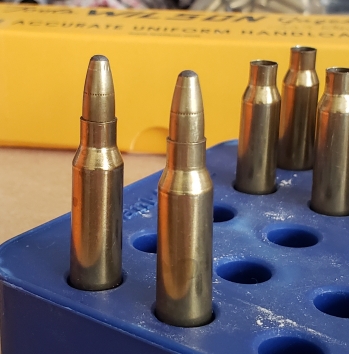Copyright 2008 – Stephen Redgwell

How are they made? (Briefly)
My bullet cores start as coils of lead wire. I cut the wire into smaller pieces and squeeze them into perfect little cylinders, so that they will fit inside the bullet jackets.
I process fired 22 rimfire cases into jackets in stages. First, I sort the cases by headstamp, and clean them ultrasonically. Next, I unfold the rims and heat treat the jackets. Then, I tumble them in a bath with stainless steel pins to remove the crust that forms on the outside of the case during heat treatment. The stainless steel pins also remove any remaining powder residue from inside and give the jackets a dull shine. In the picture above, you can see a rimfire case with a lead core being seated into the jacket. The lead core is pressed into the jacket under pressure. This is called core seating.

To make bullets, you squish little lead cylinders into bullet jackets, form a point, clean up and finish the tips. Whether it’s done on big, industrial presses like the ones used by Sierra or Nosler, or a small operation like mine, the same steps have to be performed. In my shop, I use three presses and other equipment to make bullets.
In addition to the presses, I have several core cutters – to cut the coils of wire into smaller pieces; two ultrasonic cleaners – to remove dirt and grit from the cases; two tumblers – to buff the finished bullets; two electronic scales – to verify the weights; a small pneumatic press, and a pile of hand tools.

After the bullets have been completely formed, the work is still not over. They have to be washed in solvent, to remove any remaining lube and tumbled in corn cob. The last part is to sort the bullets by weight, and bag and box everything. You can see the weight tag inside the plastic bag below. None of the bullets are exactly 60 or 65 grains. They are weighed and kept to a tolerance of less than one (1) percent however!
By weighing each bullet and sorting the rimfire cases by headstamp, the end product is better. Are they benchrest quality? No, but they are well made varmint bullets, formed from recycled material. That’s good for the environment, but bad for Wiley Coyote! I don’t have to do anything special to reload them.
I use either 60 or 65 grain data, depending on the weight of the bullet.



